More Tricks from Adobe Acrobat
The long-anticipated next version of Adobe Acrobat has been shipping for a while and whether you need the full version of Acrobat or not, you should download and install the new version of the free Adobe Reader. This is Acrobat X (X is pronounced "ten" instead of "ecks".) Version X of Acrobat is the only application that didn't ship with the original CS5 version of the other Creative Suite applications, so the upgrade comes at no cost to CS5 users.
I was surprised to find that Acrobat X still has an old-style interface, which is to say without tabs. All of the other CS5 applications have tabbed interfaces. But the improved features more than make up for this apparent shortcoming.
Acrobat Reader
I reiterate: Even if you don't need the full application, you should download and install the latest version of the free Acrobat Reader.
Before version X, the ability to add comments to a PDF could be enabled by the creator of the document, but by default Reader users had no ability to add comments or save the file. Now some comment types are enabled by default and users can save the file. Richer capabilities can be extended to Reader users if the file creator chooses to enable Reader Rights.
Unfortunately, the creator of the document must enable Reader Rights if the PDF contains a form even though, it seems to me, the mere presence of a form should enable the ability to fill out the form and save it.
 Annoyance Alert: By default, the installation comes with a McAfee Antivirus scanner. Adobe probably earns a few dollars from McAfee, but automatically installing what can reasonably be termed "crapware" is, in my opinion, unethical.
Annoyance Alert: By default, the installation comes with a McAfee Antivirus scanner. Adobe probably earns a few dollars from McAfee, but automatically installing what can reasonably be termed "crapware" is, in my opinion, unethical.
Watch the installation carefully.
That's the only annoyance, though. Download the Adobe Reader here.
Adobe Acrobat Pro
PDF portfolios are almost ready for prime time. This is a feature that Adobe has been working on for a while and it continues to improve. The user still doesn't have as much control over the output as most graphic designers will want, but that's probably coming in the next version.
Portfolios allow users to combine various kinds of files into a single package with a table of contents. If you want to use this, be sure to check out Anne-Marie Concepcione's "Creating and Working with Portfolios" at Lynda.com.
Acrobat is often used in preparing publications for print. A new feature allows multiple users to add comments and annotations to a PDF file and return them to the author or editor. The files may be merged in a way that combines comments from each user into a single file and displays them in a threaded list.
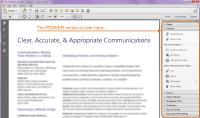 Although the interface seems to be slightly behind the rest of the CS5 suite, the new interface is probably the first thing most users will notice. The menu is simplified and the real power center is now in a Tools pane that you can display on the right side of the main window.
Although the interface seems to be slightly behind the rest of the CS5 suite, the new interface is probably the first thing most users will notice. The menu is simplified and the real power center is now in a Tools pane that you can display on the right side of the main window.
Maybe you noticed that big Create button on the upper left side of the window. Click it and you'll see a list of ways that you might create a new PDF. To make a PDF from a scanned document in previous versions, you would have to choose one of several modes to use. Acrobat is now smart enough to choose the best option itself (if you disagree, you can override Acrobat's choice) so if you have an automatic document feeder (ADF), you can just load it up and click Start.
My next scanner is going to have an automatic document feeder. When I see something that I want to follow up in a magazine, I tear out a page. Then I put the page on a stack of other pages. Somebody at Adobe apparently thought "What if I could capture all of these pages electronically?"
And it's not just scanning. Acrobat X includes optical character recognition (OCR) that can search for text within a scanned document. Better compression makes the scanned documents smaller, too. Acrobat can convert black-and-white, grayscale, and color paper documents into searchable PDF documents or you can export scanned PDF documents to Microsoft Office formats for further editing.
You're probably wondering just how well this would work. Fair enough. Let's take a look.
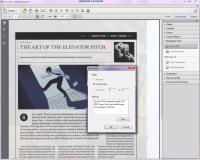 The Art of the Elevator Pitch ran in the December 2010 issue of Wired magazine. I thought it was a good article and saved it for reference. Because my scanner doesn't work with Windows 7 64-bit systems (Thanks, Epson!) I can't use Acrobat do perform the scan. But once I've converted the page to a TIFF image, I could ask Acrobat to convert it to text.
The Art of the Elevator Pitch ran in the December 2010 issue of Wired magazine. I thought it was a good article and saved it for reference. Because my scanner doesn't work with Windows 7 64-bit systems (Thanks, Epson!) I can't use Acrobat do perform the scan. But once I've converted the page to a TIFF image, I could ask Acrobat to convert it to text.
 A few seconds later, the article appeared on screen as a PDF. It doesn't look much different, but now when I search for a word, Acrobat found it!
A few seconds later, the article appeared on screen as a PDF. It doesn't look much different, but now when I search for a word, Acrobat found it!
That noise you heard about 4:47 pm on Saturday, February 19, 2011, was my jaw hitting the floor.
Wow! seems like a huge understatement.
You'd like some proof? Sure. Check out the PDF.
Acrobat X is available in 3 paid versions Standard ($300/$140 upgrade), Pro ($500/$200 upgrade), and Acrobat Suite ($1200/$800 upgrade). The Pro version allows users to convert AutoCAD, Visio, and Microsoft Project files into PDF format. The Suite adds Photoshop CS5 and Captivate CS5.
 Bottom Line: Acrobat keeps learning better and more amazing tricks.
Bottom Line: Acrobat keeps learning better and more amazing tricks.
Print professionals know that Acrobat is a must-have application, but most office workers make do with just the free Reader product. The ability by Acrobat X to scan documents, convert the scanned documents to text, and then save them as PDFs might be enough that even a penny-pinching manager will realize the logic of investing in the extra features.
For more information, visit the Adobe website.
Microsoft Challenges the Status Quo with IE 9
Conventional "wisdom" suggests that Microsoft needs 3 tries to get something more or less right. Internet Explorer was a disaster. Internet Explorer 2 was marginally acceptable. Internet Explorer 3 brought Microsoft even with Netscape. Netscape no longer has a browser but Firefox carries on the tradition. Opera and Google Chrome compete in an increasingly crowded market place. Nine is 3 squared so, if the magic number 3 is important to Microsoft, this should be it.
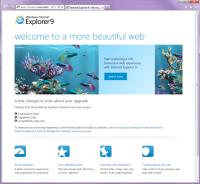 Version 9 hasn't been released yet, but the release candidate (RC) is available and Microsoft says more than 2000 changes have been made between the beta and the RC to improve browser performance, including improvements that make the browser start faster, load Web pages faster, and interact with Web pages faster. It may be worth noting here that some of those improvements are probably the result of removing debugging code that's always left in the beta versions.
Version 9 hasn't been released yet, but the release candidate (RC) is available and Microsoft says more than 2000 changes have been made between the beta and the RC to improve browser performance, including improvements that make the browser start faster, load Web pages faster, and interact with Web pages faster. It may be worth noting here that some of those improvements are probably the result of removing debugging code that's always left in the beta versions.
This version of IE essentially gets out of the user's way and I like that. The interface is a lot cleaner than its ever been and it supports HTML5, the latest revision of the HTML standard that was developed in 1990. HTML 5 is still in development. The goals include improving the language by providing support for the latest multimedia while keeping it easily readable by humans and consistently understood by computers and devices. That's a big order.
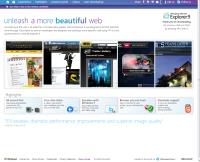 IE 9 has a new JavaScript engine called Chakra and the developers have tuned it to work well in common situations found on websites. According to Microsoft, Chakra uses advanced techniques traditionally found only in desktop optimizing compilers.
IE 9 has a new JavaScript engine called Chakra and the developers have tuned it to work well in common situations found on websites. According to Microsoft, Chakra uses advanced techniques traditionally found only in desktop optimizing compilers.
Most browsers don't currently take advantage of the graphical processing unit (GPU) that's present in most computers. Instead, they depend on the central processing unit (CPU) to do all the work. IE 9 uses the GPU, when appropriate, to make websites faster and Microsoft says that IE 9 will be the first browser to do this.
Individual tabs are available on the Task Bar (below). Hovering the mouse over the IE icon shows all of the open tabs, just as other applications do in Windows 7. You can include multiple home pages in a single pinned site and then open them all simultaneously. This doesn't bring anything new to the table that hasn't been possible with Firefox, Chrome, or Opera.

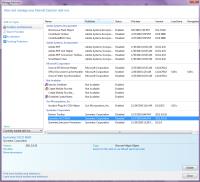 As with other coming-generation browsers, IE will allow you to limit what a website can track. A tracking protection list is used to specify which sites can track you and how.
As with other coming-generation browsers, IE will allow you to limit what a website can track. A tracking protection list is used to specify which sites can track you and how.
IE 9 also gives the user improved control over browser helper objects (BHO), which have been used as vectors for viruses and other malware.
Microsoft continues to use ActiveX, which allows Web developers to create interactive content but can also be a large security risk. A new IE 9 setting allows the user to block ActiveX controls for all sites by default and then to enable the feature only for trusted sites.
Unfortunately, if you're still using Windows XP, Internet Explorer 9 is not for you. That's not unexpected for an operating system that's ten years old. XP was released on August 24, 2001, and although it proved to be a reliable operating system, it's time to move on. For more information, see Microsoft's Beauty of the Web website.
Oh ... and if you've already downloaded the Firefox 4 beta, be sure to view the Beauty of the Web effects with it. What' you'll see is some of HTML5's magic.
Completely Unrelated to Anything Else in Today's Report
I woke up at the usual time on Saturday (5am) but decided to go back to sleep. At 6, I woke up again thinking about revolution, the Internet, and mass media. Naturally something John F. Kennedy said nearly 50 years ago occurred to me. (Naturally!?) Surprisingly, these all seem to fit together into a single more or less logical sequence.
http://www.techbyter.com/today/archives/210
Short Circuits
The Fury of G-mail Users
There's no easier way to make people furious, it seems, than to offer a free service that isn't 100 percent reliable. This week tens of thousands of G-mail users lost access to their mailboxes temporarily. One might have been forgiven for thinking that not having access to an e-mail account for a couple of hours constituted a disaster. And some media outlets howled that e-mail had been "lost". Not exactly.
Google does have some paying customers. Business, education, and government users pay $50 per year per account, which is probably quite a bit less than it would cost to run a server, provide security, manage and back up the system, offer support, and so on. Following an outage last year, Google gave paid users 15 days free. (Value: About $2 per user.) I can understand the frustration of those who pay for the service and even, to some extent, those who use it for free.
The problem that affected, by Google's admission, most G-mail users affected me not a bit and this isn't because I shun G-mail. Certain network changes at the office make Web mail my only option from there. G-mail is the best Web mail service available, but it's still Web mail. Even the best crap is still crap.
To put this into perspective, the outage lasted for about 1 hour and 45 minutes. During the "outage", users could still use POP or IMAP e-mail applications to send and receive mail and many users who have a personalized Google page were able to use G-mail from there. In other words, this was essentially a non-event that was perceived as a disaster.
Others, including some who are technologically literate, have said that this kind of event is why they'll never trust online applications ("in the cloud"). They're concerned that their information will just disappear someday, but I would be willing to wager that Google has a more robust backup system than 99.999% of all home users (including me) and a more robust backup system than at least 80% of business users.
I'm not a big fan of online applications because they're generally slower and less feature rich than PC-based applications, but the security of my online data isn't a significant concern. I keep a local copy of everything I have online. The online copy is backed up. The local copy is backed up, both locally and to an online service.
In many ways, this attitude of fear mirrors that of people who refused to use ATMs at banks or demanded passbooks so they could see their money. Unfamiliarity causes us to behave this way. I wonder if restaurants were slow to catch on because people felt they were no longer in control of their food.
Apple Ipad 2
Yes, there is one. Steve Jobs came back from medical leave to introduce it.
The new Ipad has cameras front and rear. There must be a joke in there somewhere, but I can't come up with it. You can buy one starting on March 11. $500 for the paperweight and $830 for the one that's usable.
Well, I had to mention it or you'd think I wasn't paying attention.
The Nation of Facebook
If Facebook was a country, it would be the third largest country on the planet. Ahead of the United States and behind only China and India. Now Facebook has acquired Beluga, a start-up that provides "group messaging" for mobile phones. In some previous cases, Facebook has acquired companies as part of a talent hunt, kept the talent, and killed the companies. But it appears that Facebook sees value in the service Beluga provides.
And this is not Beluga, the expensive Russian vodka.
 At left you see the company's logo.
At left you see the company's logo.
The three Beluga developers are all former Google employees, so we'll have to assume that they technologically very smart. Those who have used the application say that the design is excellent.
Facebook's public statement on the merger gives users hope that the service will continue: "For now, Beluga will continue to function as it does today. Beluga accounts and data will not be lost. We'll be providing more details on future plans for Beluga in the coming weeks."
The application allows users to create "pods" (groups of friends) who can then stay connected via smartphone. I don't have a smart phone, but I can see how it could be a most attractive application.
To see what Beluga is all about, visit the BelugaPods website.


 The author's image: It's that photo over at the right. This explains why TechByter Worldwide was never on television, doesn't it?
The author's image: It's that photo over at the right. This explains why TechByter Worldwide was never on television, doesn't it?
